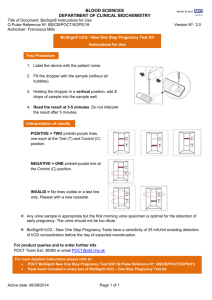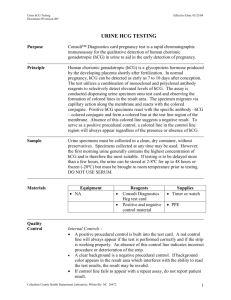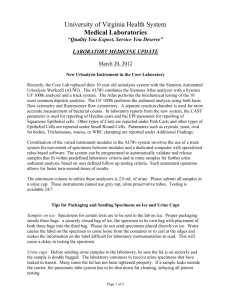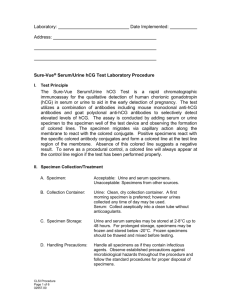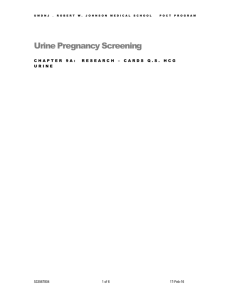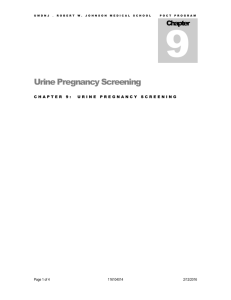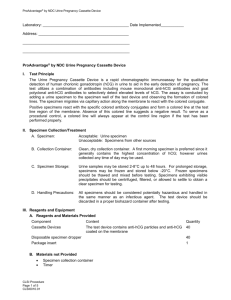Pregnancy Test, Qualitative
advertisement
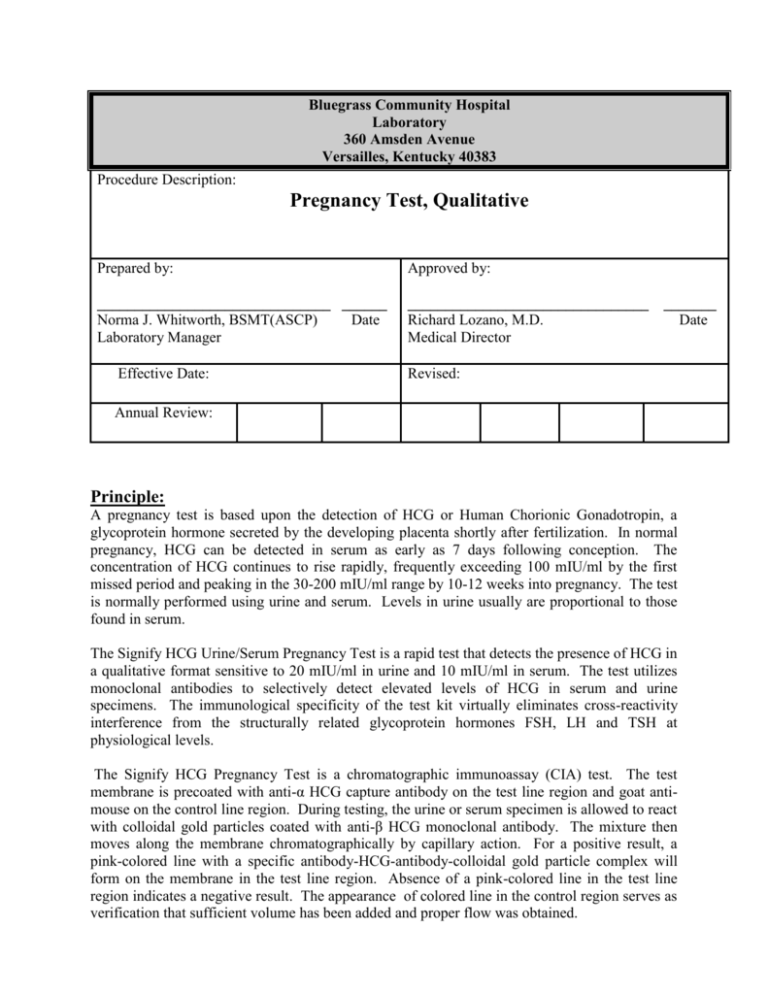
Bluegrass Community Hospital Laboratory 360 Amsden Avenue Versailles, Kentucky 40383 Procedure Description: Pregnancy Test, Qualitative Prepared by: Approved by: _______________________________ ______ Norma J. Whitworth, BSMT(ASCP) Date Laboratory Manager ________________________________ Richard Lozano, M.D. Medical Director Effective Date: _______ Date Revised: Annual Review: Principle: A pregnancy test is based upon the detection of HCG or Human Chorionic Gonadotropin, a glycoprotein hormone secreted by the developing placenta shortly after fertilization. In normal pregnancy, HCG can be detected in serum as early as 7 days following conception. The concentration of HCG continues to rise rapidly, frequently exceeding 100 mIU/ml by the first missed period and peaking in the 30-200 mIU/ml range by 10-12 weeks into pregnancy. The test is normally performed using urine and serum. Levels in urine usually are proportional to those found in serum. The Signify HCG Urine/Serum Pregnancy Test is a rapid test that detects the presence of HCG in a qualitative format sensitive to 20 mIU/ml in urine and 10 mIU/ml in serum. The test utilizes monoclonal antibodies to selectively detect elevated levels of HCG in serum and urine specimens. The immunological specificity of the test kit virtually eliminates cross-reactivity interference from the structurally related glycoprotein hormones FSH, LH and TSH at physiological levels. The Signify HCG Pregnancy Test is a chromatographic immunoassay (CIA) test. The test membrane is precoated with anti-α HCG capture antibody on the test line region and goat antimouse on the control line region. During testing, the urine or serum specimen is allowed to react with colloidal gold particles coated with anti-β HCG monoclonal antibody. The mixture then moves along the membrane chromatographically by capillary action. For a positive result, a pink-colored line with a specific antibody-HCG-antibody-colloidal gold particle complex will form on the membrane in the test line region. Absence of a pink-colored line in the test line region indicates a negative result. The appearance of colored line in the control region serves as verification that sufficient volume has been added and proper flow was obtained. Precautions: For in vitro diagnostic use only. For professional and laboratory use only. Do not use the test kit beyond the expiration date. Do not reuse. Discard the device if pouch is ripped, torn or if the device itself is damaged. Storage and Stability: The Signify Pregnancy Test devices should remain sealed in the pouch and can be sored either refrigerated (2 – 8 °C) or at room temperature (2 – 30 °C) until use or the stated expiration date. Specimen Collection and Handling: Urine Specimems: The urine specimen must be collected in a clean, dry container. Specimens can be collected at any time of day, however, first morning specimens are preferred due to their higher concentrations of hormone. Specimens may be refrigerated (2 – 8 °C) and stored up to 72 hours prior to testing. If specimens are refrigerated, they must be allowed to equilibrate to room temperature before testing. Urine specimens with visible precipitates should be centrifuged or allowed to settle prior to testing. Serum Specimens: Collect serum in a plain red top or SST rube. Plasma is NOT acceptable. Specimens may be stored up to 72 hours refrigerated (2 – 8 °C) or frozen (-20 °C) for up to 3 months. Do not freeze and thaw specimen repeatedly. Grossly hemolyzed specimens should not be used. Frozen or refrigerated specimens must be allowed to equilibrate to room temperature prior to testing. Materials Needed: 1. 2. 3. 4. 5. Signify Test device Timer Pipette (included in test kit pouch) Disposable plastic collection container. HCG controls (Biorad urine controls and Quality Control (QC): Internal QC: A colored line appearing on the control region is considered an internal positive procedural control, indicating proper testing performance: A clear background in the result window is considered an internal negative procedural control. If the test is working properly and has been performed correctly, the background will clear giving a distinct result. Document the internal positive and negative QC for each test performed on Serology Log. External QC: External QC is ran for every new test kit opened and as needed. Document results on Serology Log. a.) Urine Controls: Biorad Urine Controls Level 1 and 2 are used for the positive and negative external QC. b.) Serum Controls: A frozen patient serum is used for the positive control. Patient quantitative HCG result is kept filed in Hematology. Approximately 400ul of patient specimen is aliquoted to a plastic specimen tube. Tube is labeled with patient name, ID#, date of collection and placed into specimen rack labeled as HCG Serum Positive Control. Specimens are stored in Plasma Freezer (-20°C). Frozen control must be allowed to equilibrate to room temperature prior to testing. The positive patient serum control is stable for 1 year. A male patient’s serum is used as the negative serum control. Obtain a male serum specimen from current day’s specimens. Procedure: 1.) Have patient collect a urine specimen in a clean plastic container. For serum, phlebotomist should collect a red top or SST tube. Refer to “Specimen Collection SOP” for details regarding venipunctures or fingerstick procedures. Centrifuge tube for 5 minutes to separate cells from serum. 2.) Remove Test Device and Pipette from test foil pouch. Place on a flat surface. 3.) Label device with patient name or Meditech Label for identification. 4.) Squeeze bulb of pipette and place into patient or control specimen. Release bulb slowly to draw specimen into pipette up to line marked on pipette (0.2 ml). 5.) Dispense the entire contents of pipette into sample well. 6.) Set a timer for 5 minutes. 7.) Read results and document on Serology Log and in Meditech. Do not interpret result after 10 minutes. 8.) Discard test device and pipette into biohazard waste container. Cap patient’s specimen and store urine in Hematology refrigerator draw labeled accordingly for urine specimens and red or SST tube in daily specimen rack. Urine specimens are stored for 48 hours and serum for 7 days. Results and Interpretation: POSITIVE: Two distinct pink-colored lines appear. One line in the control region (C) and another colored line in the test region (T). The color intensity on the test line (T) may vary depending on the concentration of HCG present. However, neither the quantitative value nor the rate of increase in HCG can be determined by a qualitative test. NEGATIVE: Only one pink-colored line appears in the control region (C). No distinct pink-colored line appears in the test region (T). Negative test results in patients suspected to be pregnant should be retested with a new specimen obtained 48 – 72 hours later, or perform a quantitative assay test. INVALID: Absence of a pink-colored line in the control region is an indication of procedural error or that the test reagent deterioration might have occurred. Repeat test with a new device and read for presence of a colored control line. If problem persists, call Technical Service at : 1(800) 257-9525. Limitations: 1.) A number of conditions other than pregnancy including trophoblastic disease and certain nontrophoblastic neoplasms can cause elevated levels of HCG. The test is not intended to diagnose conditions other than pregnancy. 2.) If a urine specimen is too dilute, it may not contain representative levels of HCG. If pregnancy is still suspected, a first morning urine should be obtained from the patient 4872 hours later and retested. 3.) As with all diagnostic tests, a definitive clinical diagnosis should not be based on the result of a single test, but should only be made by a physician after all clinical and laboratory findings have been evaluated. 4.) Immunologically interfering substances such as those used in antibody therapy treatments may invalidate the test result. 5.) Some specimens containing very high levels of HCG (≈600 IU/ml) may yield a test line with a color intensity lighter than expected. When high dose “hook effect” is suspected, a 1:10 dilution of the specimen with distilled water is recommended. The test should then be repeated with the diluted specimen. 6.) The presence of heterophile antibodies or non-specific protein binding may cause falsepositive results in sensitive immunoassays. If a qualitative interpretation is inconsistent with the clinical evidence, results should be confirmed by an alternative HCG method. Expected Values: Healthy men and non-pregnant women do not have HCG levels detectable by the Signify HCG Pregnancy Test. For pregnant women, HCG levels of 50 – 250 mIU/ml can be reached on the day of the first missed menstrual period. HCG levels peak about 8 – 10 weeks after the last menstrual period and then decline to lower values for the remainder of the pregnancy. Following delivery, HCG levels rapidly decrease and usually return to normal within days after parturition. References: 1.) Signigy Package Insert, Inverness Medical, Princeton, NJ. April, 2004 2.) Jacobs, Demott, Finley, Horvat, Kasten Jr., Tilzer: “Laboratory Test Handbook,” 3rd ED., Lexi-Comp Inc., Hudson, Ohio, 1992.

